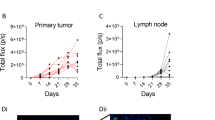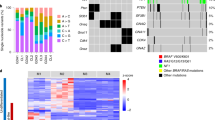Abstract
Incidence and mortality of human malignant melanoma has risen rapidly over recent decades. Although the notorious resistance to treatment is characteristic for metastatic malignant melanoma, only a few experimental models have been established to study the metastatic cascade or to test new alternative treatment modalities. Thus, new human models are wanted. Here, we describe the metastatic behaviour of seven human melanoma cell lines derived from two primary cutaneous melanomas (WM 98-1, WM 1341) and five metastases established from liver (UKRV-Mel-4), skin (M7, M13), pleural effusion (UKRV-Mel-2) and lymph node (MV3). All cell lines were analysed for their capacity to grow in nude mice after s.c. and i.v. administration. M13 cells developed liver metastases spontaneously after s.c. injection, and subsequent passages of M13 and M7 melanoma cells caused liver metastases after i.v. injection, whereas MV3 and WM98-1 gave rise to lung metastases, using the same inoculation route. In contrast, WM 1341, UKRV-Mel-2 and UKRV-Mel-4 grew only very slowly in nude mice after s.c. injection and did not cause any metastases after i.v. or s.c. administration. The pattern of metastases or growth kinetics did not correlate with the interleukin 8 or tumour necrosis factor secretion of cell lines. Adhesion molecules and growth factor receptor expression on the cell lines differed widely, as determined by flow cytometry, with the low metastatic cell lines (UKRV-Mel-2, UKRV-Mel-4 and WM 1341) demonstrating a marked reduction in VLA-1 and VLA-5 expression compared with the metastatic lines (M7, M13, MV3 and WM 98-1). Expression of pigment-related proteins such as tyrosinase, TRP-1, TRP-2, Melan-A/MART-1, gp100, MAGE1 or MAGE-3 was not associated with growth and metastatic characteristics of the melanoma cell lines analysed. In conclusion, the established human melanoma cell lines exhibited diverse growth behaviour in nude mice in congruence with some early established prognostic markers such as VLA-1 and VLA-5. The xenografts provide good models for further study of metastatic processes as well as for evaluation of alternative treatment modalities including new pharmaceutical drugs and gene therapeutic targeting using tissue-specific gene regulatory elements for gene targeting.
This is a preview of subscription content, access via your institution
Access options
Subscribe to this journal
Receive 24 print issues and online access
$259.00 per year
only $10.79 per issue
Buy this article
- Purchase on Springer Link
- Instant access to full article PDF
Prices may be subject to local taxes which are calculated during checkout
Similar content being viewed by others
Author information
Authors and Affiliations
Rights and permissions
About this article
Cite this article
Schadendorf, D., Fichtner, I., Makki, A. et al. Metastatic potential of human melanoma cells in nude mice - characterisation of phenotype, cytokine secretion and tumour-associated antigens. Br J Cancer 74, 194–199 (1996). https://doi.org/10.1038/bjc.1996.337
Issue Date:
DOI: https://doi.org/10.1038/bjc.1996.337
This article is cited by
-
Cytotoxicity, acute and sub-chronic toxicities of the fruit extract of Tetrapleura tetraptera (Schumm. & Thonn.) Taub. (Fabaceae)
BMC Complementary Medicine and Therapies (2022)
-
CC chemokine receptor 10 cell surface presentation in melanocytes is regulated by the novel interaction partner S100A10
Scientific Reports (2016)
-
RETRACTED ARTICLE: Overexpression of interleukins IL-17 and IL-8 with poor prognosis in colorectal cancer induces metastasis
Tumor Biology (2016)
-
Differential regulation of CXC ligand 1 transcription in melanoma cell lines by poly(ADP-ribose) polymerase-1
Oncogene (2006)
-
NF-κB, chemokine gene transcription and tumour growth
Nature Reviews Immunology (2002)



